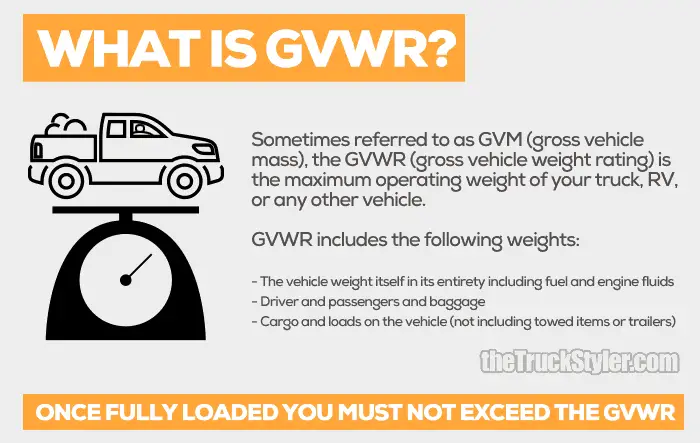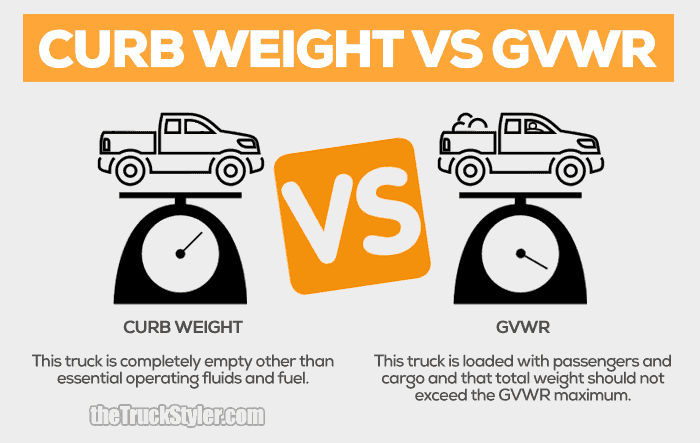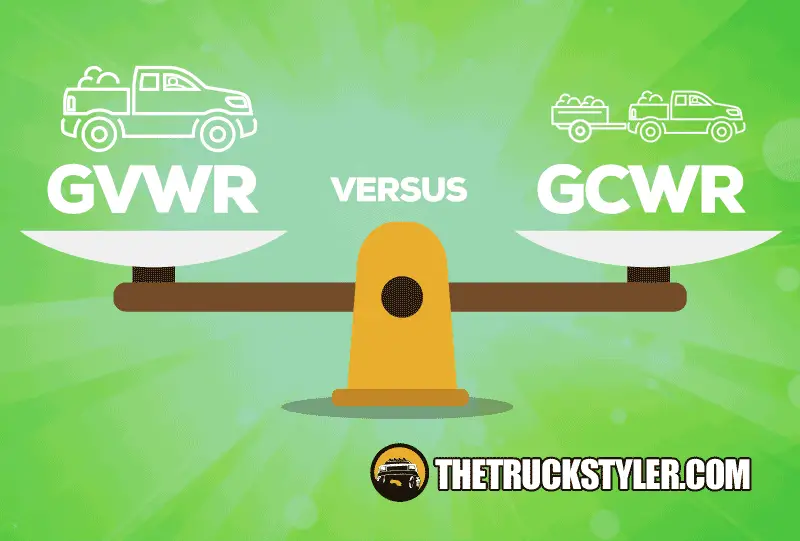If you’re new to trucks and trailering, chances are you are getting a little bit overwhelmed by all the different talks around payload, weight capacity, towing capacity, GVWR versus GCWR, and so on… it’s confusing and it’s hard to initially get your head around what the differences are.
But you shouldn’t ignore it or not learn it, as if you get these measurements wrong you could damage your truck, trailer, or RV, and even put people’s lives at risk.
This guide on GVWR versus GCWR is a simple guide to what it all means, and what the differences are in the terminology being used.
You won’t even need to grab a coffee as it’s going to be that quick and easy to understand the differences. Just sit tight and read on and within a couple of minutes, you are going to know all there is to know about how this stuff all works and relates to each other.
What is GVWR?
Sometimes referred to as GVM (gross vehicle mass), the GVWR (gross vehicle weight rating) is the maximum operating weight of your truck, RV, or any other vehicle.

The manufacturers determine GVWR during the testing phase of development, before the vehicle comes onto the market, and you can usually find it in either your vehicle’s user manual or stuck inside of the door frame.
GVWR includes the following weights:
- The vehicle weight itself in its entirety including fuel and engine fluids
- Driver and passengers
- Cargo and loads on the vehicle (not including towed items or trailers)
In simple terms, it’s the safest weight that your truck or vehicle can travel with when fully loaded, including the weight of the vehicle itself.
GVWR Max. Limit = Total Vehicle Weight + Cargo + Driver + Passengers
When you know the GVWR, that’s the weight you can’t exceed.
Just imagine placing the truck or RV on a giant set of scales once fully loaded, minus any trailer. If you’re exceeding the GVWR weight at this point, you need to take stuff off.
What is GCWR?
Sometimes referred to as GCM (gross combination mass) or MAM (maximum authorised mass), the GCWR (gross combination weight rating) is the maximum amount of weight that the truck or vehicle is, with passengers and load, PLUS the mass of any trailer and load being pulled behind.
In simple terms, it’s the same as GVWR, but you’re adding a trailer and load on the back of the truck or RV as well.

It’s only something that you would ever really need to know if you are planning on a towing a trailer or similar.
The GCWR of your truck, RV, or vehicle can usually be found inside the door frame on the driver’s side. If it’s not there, Google it, or phone up a manufacturer or dealer.
As with GVWR, GCWR is set by the vehicle’s manufacturer after they have done extensive safety testing during the development phase, before the going on sale to the general public.
In simple terms, it’s the safest weight that your truck or vehicle can travel with when fully loaded, including the weight of the vehicle itself PLUS a trailer weight and load being pulled.
GCWR Max. Limit = (Total Vehicle Weight + Cargo + Driver + Passengers) + (Total Trailer Weight + Cargo)
Once you know the maximum GCWR of your total weight on the road, that’s the figure you should not exceed when towing or trailering.
What is Curb Weight?
Imagine you’ve stepped out of your truck, it’s free of any cargo, there’s nobody else in it, and you’re admiring how great it looks – hopefully!
The curb weight is how much it weighs when parked up with nothing and nobody in it.
It’s that simple.
What is the Difference Between GVWR and GCWR?
OK so hopefully everything is pretty clear by now on what the difference between GVWR and GCWR is.
GVWR (Gross Vehicle Weight Rating): The maximum weight of the truck, RV, or vehicle once it’s fully loaded up and ready to hit the road. Includes absolutely everything that you would carry including passengers and cannot be exceeded.
GCWR (Gross Combined Weight Rating): The maximum combined weight of the towing vehicle and the trailer that’s being pulled, with everything in it. This weight rating must not be exceeded.
But just in case you need a little more clarity, I’ve designed this little graphic to put everything a little more into perspective.

What Does GVWR Mean for a Truck?
All trucks will have been tested to come with a GVWR or gross vehicle mass (GVM).
It’s the maximum operating weight of the truck, and it’s set by the manufacturer for safety reasons. It will include:
- Chassis
- Body
- Engine
- Engine fluids
- Fuel
- Accessories
- Baggage
- Driver
- Passengers
- Cargo loads
It excludes the weight of any trailer that’s attached, loaded, and being pulled by the truck.
How to Calculate GVWR
You can find your GVWR by looking for the sticker or plate inside of the truck, so the more important consideration here is how to calculate that you’re not exceeding your GVWR.
To do so, you will need to know your truck’s curb weight. If you know how much that weighs, you will then need to know what the weight of everything else is that you’re placing into the truck including people, baggage, and a load in the bed.
Add all that weight together before you load the truck and check that it doesn’t exceed the stated GVWR.
Figuring out and calculating the payload capacity takes the form of this simple to use calculation:
GVWR – Curb Weight = Truck Payload Capacity
To find out more about how to calculate how much your truck can safely carry, please read this guide to calculating payload capacities.
How to Calculate GCWR
Again, you should be able to find the GCWR inside the frame of your truck, typically near the driver’s door side.
Once you have that figure, you will then need to know what the weight of your trailer and the trailer load is combined.
Add up the total weight of your truck including passengers and cargo, and then add the total weight of the trailer and carried load.
If that combined weight exceeds your GCWR, then you shouldn’t be pulling.
It’s also worth mentioning at this point, that a trailer will also have its own maximum weight limits, so you need to check and adhere to that limit too to ensure safe towing.
Why This is So Important
By now you should be clear on the GVWR versus GCWR differences and debate.
The reason it’s so important is that if you do exceed either of these ratings, you risk damaging your truck and trailer.
You could in worst cases, get a cracked frame and chassis, or at the very least put strain and stresses on the truck which is going to lead to expensive repairs.
But by far and away the most important consideration is safety.
If you’re exceeding the GCWR or GVWR of your truck and trailer, your stopping distances could become a lot shorter, and you might not even be able to brake in time at all.
The consequences could be extremely serious to both you, your passengers, and other road users.
Make sure you know the differences before it’s too late.


